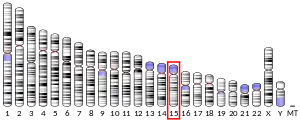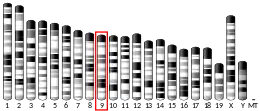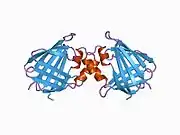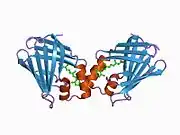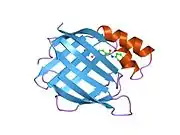| CRABP1 | |||||||||||||||||||||||||||||||||||||||||||||||||||
|---|---|---|---|---|---|---|---|---|---|---|---|---|---|---|---|---|---|---|---|---|---|---|---|---|---|---|---|---|---|---|---|---|---|---|---|---|---|---|---|---|---|---|---|---|---|---|---|---|---|---|---|
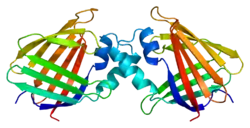 | |||||||||||||||||||||||||||||||||||||||||||||||||||
| Identifiers | |||||||||||||||||||||||||||||||||||||||||||||||||||
| Aliases | CRABP1, CRABP, CRABP-I, CRABPI, RBP5, cellular retinoic acid binding protein 1 | ||||||||||||||||||||||||||||||||||||||||||||||||||
| External IDs | OMIM: 180230 MGI: 88490 HomoloGene: 3222 GeneCards: CRABP1 | ||||||||||||||||||||||||||||||||||||||||||||||||||
| |||||||||||||||||||||||||||||||||||||||||||||||||||
| |||||||||||||||||||||||||||||||||||||||||||||||||||
| |||||||||||||||||||||||||||||||||||||||||||||||||||
| |||||||||||||||||||||||||||||||||||||||||||||||||||
| |||||||||||||||||||||||||||||||||||||||||||||||||||
| Wikidata | |||||||||||||||||||||||||||||||||||||||||||||||||||
| |||||||||||||||||||||||||||||||||||||||||||||||||||
Cellular retinoic acid-binding protein 1 is a protein that in humans is encoded by the CRABP1 gene.[5][6]
CRABP1 is assumed to play an important role in retinoic acid-mediated differentiation and proliferation processes. It is structurally similar to the cellular retinol-binding proteins, but binds only retinoic acid. CRABP1 is constitutively expressed and is believed to have different functions in the cell than the related CRABP2.[6]
Function
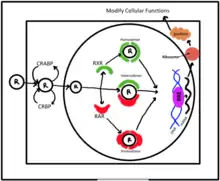
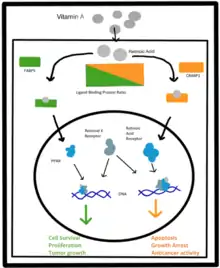

CRABP1 binds to retinoid acid and helps to transport it into the nucleus (Figure 1). Both CRABP1 and CRABP2 perform this activity. The retinoic acid molecule is then released and further bound to retinoic acid receptor (RAR) and the retinoid X receptor (RXR) as homodimers or heterodimers. This complex then further binds to retinoic acid response elements (RARE) on DNA that regulates transcription of retinoid acid dependent null genes.[10] The domains for the nuclear localization and the retinoic acid binding are shown in Figure 3.
CRABP1 has been found to be involved in multiple cancer proliferation pathways. CRABP1 activates the extracellular signal-regulated kinase, ERK1 and ERK2 kinases, which are involved in the cell cycle. CRABP1 activity can thus extend the cell cycle, e.g. in embryonic and neural stem cells. Knockout mice without CRABP1 showed increased neural stem cell proliferation and thus hippocampus neurogenesis. Furthermore, learning and memory were improved in knockout mice, as measured by the Morris water maze test and an object recognition task.[11]
CRABP1 is also involved in cancer cell apoptosis. trans-retinoic acid was considered a [null therapeutic target for cancer] as a ligand of CRABP1.[12] It was observed that CRABP1 regulated ERK1/2) which in turn activates the protein phosphatase 2A (PP2A) that induces apoptosis of cancer cells and lengthens the cell cycle of embryonic stem cells. PP2A activity promotes the stem cells renewal ability during the differentiation process. When CRABP1 was knocked down the apoptotic induction ability was also removed and allowed for cell proliferation. The re-expression of CRABP1 in CRABP1 null cells brought back the induced apoptotic activity. Thus CRABP1 may be used as a therapeutic target along with trans-retinoic acid for apoptotic activity within cancer cells.[12] Figure 2 illustrates both pathways of retinoic acid binding to CRABP for cell proliferation and apoptotic activity.
References
- 1 2 3 GRCh38: Ensembl release 89: ENSG00000166426 - Ensembl, May 2017
- 1 2 3 GRCm38: Ensembl release 89: ENSMUSG00000032291 - Ensembl, May 2017
- ↑ "Human PubMed Reference:". National Center for Biotechnology Information, U.S. National Library of Medicine.
- ↑ "Mouse PubMed Reference:". National Center for Biotechnology Information, U.S. National Library of Medicine.
- ↑ Flagiello D, Apiou F, Gibaud A, Poupon MF, Dutrillaux B, Malfoy B (Jun 1997). "Assignment of the genes for cellular retinoic acid binding protein 1 (CRABP1) and 2 (CRABP2) to human chromosome band 15q24 and 1q21.3, respectively, by in situ hybridization". Cytogenetics and Cell Genetics. 76 (1–2): 17–8. doi:10.1159/000134502. PMID 9154115.
- 1 2 "Entrez Gene: CRABP1 cellular retinoic acid binding protein 1".
- ↑ Redrawn from Lee K (April 2017). "Retinol for all". The Regime.
- ↑ Redrawn from Michalik L, Wahli W (May 2007). "Guiding ligands to nuclear receptors". Cell. 129 (4): 649–51. doi:10.1016/j.cell.2007.05.001. PMID 17512397. S2CID 17253347.
- ↑ Adapted from Universal protein resource accession number P29762 for "RABP1_HUMAN" at UniProt.
- ↑ Liu RZ, Garcia E, Glubrecht DD, Poon HY, Mackey JR, Godbout R (July 2015). "CRABP1 is associated with a poor prognosis in breast cancer: adding to the complexity of breast cancer cell response to retinoic acid". Molecular Cancer. 14: 129. doi:10.1186/s12943-015-0380-7. PMC 4491424. PMID 26142905.
- ↑ Lin YL, Persaud SD, Nhieu J, Wei LN (September 2017). "Cellular Retinoic Acid-Binding Protein 1 Modulates Stem Cell Proliferation to Affect Learning and Memory in Male Mice". Endocrinology. 158 (9): 3004–3014. doi:10.1210/en.2017-00353. PMC 5659671. PMID 28911165.
- 1 2 Persaud SD, Park SW, Ishigami-Yuasa M, Koyano-Nakagawa N, Kagechika H, Wei LN (March 2016). "All trans-retinoic acid analogs promote cancer cell apoptosis through non-genomic Crabp1 mediating ERK1/2 phosphorylation". Scientific Reports. 6: 22396. Bibcode:2016NatSR...622396P. doi:10.1038/srep22396. PMC 4776112. PMID 26935534.
Further reading
- Eller MS, Oleksiak MF, McQuaid TJ, McAfee SG, Gilchrest BA (February 1992). "The molecular cloning and expression of two CRABP cDNAs from human skin". Experimental Cell Research. 198 (2): 328–36. doi:10.1016/0014-4827(92)90387-N. PMID 1309505.
- Aström A, Tavakkol A, Pettersson U, Cromie M, Elder JT, Voorhees JJ (September 1991). "Molecular cloning of two human cellular retinoic acid-binding proteins (CRABP). Retinoic acid-induced expression of CRABP-II but not CRABP-I in adult human skin in vivo and in skin fibroblasts in vitro". The Journal of Biological Chemistry. 266 (26): 17662–6. doi:10.1016/S0021-9258(19)47422-X. PMID 1654334.
- Ong DE (December 1987). "Cellular retinoid-binding proteins". Archives of Dermatology. 123 (12): 1693–1695a. doi:10.1001/archderm.123.12.1693. PMID 2825608.
- Wang L, Li Y, Yan H (January 1997). "Structure-function relationships of cellular retinoic acid-binding proteins. Quantitative analysis of the ligand binding properties of the wild-type proteins and site-directed mutants". The Journal of Biological Chemistry. 272 (3): 1541–7. doi:10.1074/jbc.272.3.1541. PMID 8999826.
- Liu W, Hellman P, Li Q, Yu WR, Juhlin C, Nordlinder H, Rollman O, Akerström G, Törmä H, Melhus H (December 1996). "Biosynthesis and function of all-trans- and 9-cis-retinoic acid in parathyroid cells". Biochemical and Biophysical Research Communications. 229 (3): 922–9. doi:10.1006/bbrc.1996.1903. PMID 9005841.
- Kreutz M, Fritsche J, Andreesen R, Krause SW (July 1998). "Regulation of cellular retinoic acid binding protein (CRABP II) during human monocyte differentiation in vitro". Biochemical and Biophysical Research Communications. 248 (3): 830–4. doi:10.1006/bbrc.1998.9058. PMID 9704013.
- Huang Y, de la Chapelle A, Pellegata NS (May 2003). "Hypermethylation, but not LOH, is associated with the low expression of MT1G and CRABP1 in papillary thyroid carcinoma". International Journal of Cancer. 104 (6): 735–44. doi:10.1002/ijc.11006. PMID 12640681. S2CID 26461955.
- Kim SK, Yoo JI, Cho BK, Hong SJ, Kim YK, Moon JA, Kim JH, Chung YN, Wang KC (December 2003). "Elevation of CRABP-I in the cerebrospinal fluid of patients with Moyamoya disease". Stroke. 34 (12): 2835–41. doi:10.1161/01.STR.0000100159.43123.D7. PMID 14605320.
- Blaese MA, Santo-Hoeltje L, Rodemann HP (December 2003). "CRABP I expression and the mediation of the sensitivity of human tumour cells to retinoic acid and irradiation". International Journal of Radiation Biology. 79 (12): 981–91. doi:10.1080/09553000310001632949. PMID 14713576. S2CID 37684886.
- Won JY, Nam EC, Yoo SJ, Kwon HJ, Um SJ, Han HS, Kim SH, Byun Y, Kim SY (August 2004). "The effect of cellular retinoic acid binding protein-I expression on the CYP26-mediated catabolism of all-trans retinoic acid and cell proliferation in head and neck squamous cell carcinoma". Metabolism. 53 (8): 1007–12. doi:10.1016/j.metabol.2003.12.015. PMID 15281009.
- Ahn J, Chung KS, Kim DU, Won M, Kim L, Kim KS, Nam M, Choi SJ, Kim HC, Yoon M, Chae SK, Hoe KL (November 2004). "Systematic identification of hepatocellular proteins interacting with NS5A of the hepatitis C virus". Journal of Biochemistry and Molecular Biology. 37 (6): 741–8. doi:10.5483/bmbrep.2004.37.6.741. PMID 15607035.
- Pfoertner S, Goelden U, Hansen W, Toepfer T, Geffers R, Ukena SN, von Knobloch R, Hofmann R, Buer J, Schrader AJ (2005). "Cellular retinoic acid binding protein I: expression and functional influence in renal cell carcinoma". Tumour Biology. 26 (6): 313–23. doi:10.1159/000089262. PMID 16254461. S2CID 21446812.
- Lind GE, Kleivi K, Meling GI, Teixeira MR, Thiis-Evensen E, Rognum TO, Lothe RA (2007). "ADAMTS1, CRABP1, and NR3C1 identified as epigenetically deregulated genes in colorectal tumorigenesis". Cellular Oncology. 28 (5–6): 259–72. doi:10.1155/2006/949506. PMC 4618201. PMID 17167179.
- Tanaka K, Imoto I, Inoue J, Kozaki K, Tsuda H, Shimada Y, Aiko S, Yoshizumi Y, Iwai T, Kawano T, Inazawa J (September 2007). "Frequent methylation-associated silencing of a candidate tumor-suppressor, CRABP1, in esophageal squamous-cell carcinoma". Oncogene. 26 (44): 6456–68. doi:10.1038/sj.onc.1210459. PMID 17438526. S2CID 5670509.
- Wu Q, Lothe RA, Ahlquist T, Silins I, Tropé CG, Micci F, Nesland JM, Suo Z, Lind GE (July 2007). "DNA methylation profiling of ovarian carcinomas and their in vitro models identifies HOXA9, HOXB5, SCGB3A1, and CRABP1 as novel targets". Molecular Cancer. 6: 45. doi:10.1186/1476-4598-6-45. PMC 1964763. PMID 17623056.
External links
- Human CRABP1 genome location and CRABP1 gene details page in the UCSC Genome Browser.
- Human RBP5 genome location and RBP5 gene details page in the UCSC Genome Browser.
